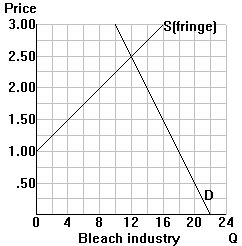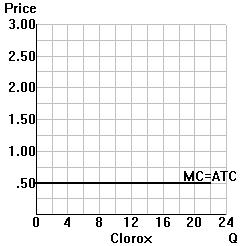

| Jim Whitney | Economics 250 |


1. Suppose Clorox did not exist: Equilibrium quantity = ______ Equilibrium price = ______
2. Complete the following table to determine points on the demand curve facing Clorox:
| Price | Total quantity demanded | Quantity supplied
by fringe |
Excess demand = quantity
demanded of Clorox bleach |
| $2.50 | 12 | 12 | 0 |
| 2.00 | 14 | 8 | 6 |
| 1.50 | |||
| 1.00 | |||
| .50 |
3. Plot the demand curve for Clorox in the righthand panel above.
4. Derive the marginal revenue curve (MRc) for Clorox,
and determine the profit-maximizing optimum.
Price = ______
Quantity supplied by Clorox
= ______
Quantity supplied by fringe
= ______
Quantity consumed = ______
5. In the righthand panel, indicate the profits and welfare loss associated with Clorox acting as a price leader instead of producing the efficient quantity.
6. Clorox's profits = ______
Suppose instead that Clorox produces just enough
to capture the entire bleach market. Clorox's new profits = ______